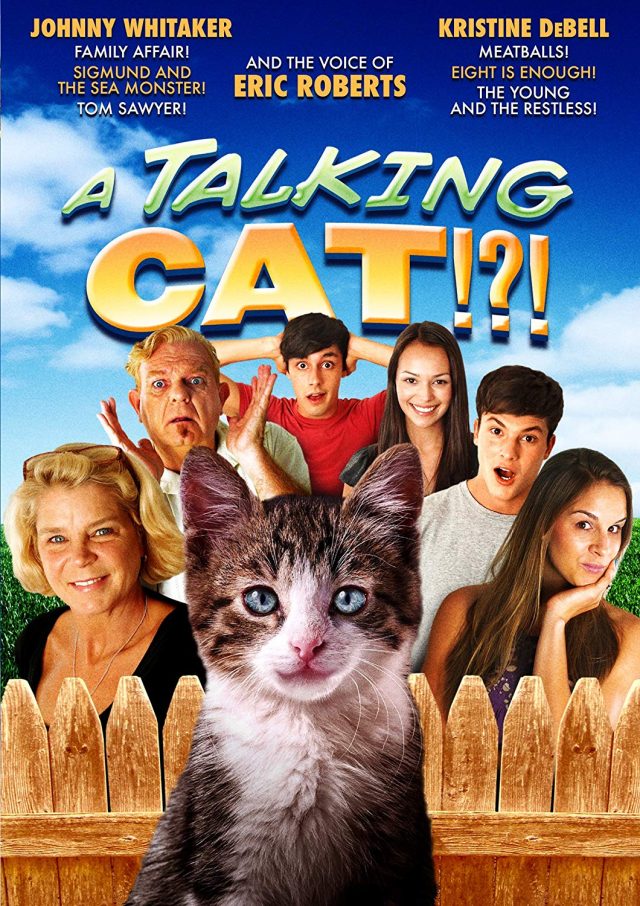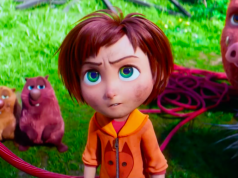
There is no universally agreed upon translation, but my best guess at interpreting the title of “A Talking Cat!?!” is that we are initially astonished by the idea of a cat who talks; this is quickly followed by an air of skepticism, even doubt; but we are at last astonished again, this time with an air of excitement and thrill at our discovery. If you think about it, that’s really the whole sum of the human experience, all encapsulated by the punctuation choices of the well-meaning but incapable people who made this movie.
“A talking cat!?!” you say, or perhaps scream. Yes, the subject of “A Talking Cat!?!” is indeed a talking cat (!?!), a wry fellow named Duffy who we are led to understand goes from place to place, Mary Poppins-like, bringing families together with his feline wisdom. Duffy does not speak aloud very often; mostly we hear his thoughts, which are voiced by Eric Roberts, who sounds world-weary and gruff. He also sounds echoey and hollow, as if the filmmakers recorded him not in a studio but over the phone or in a parking garage. You could probably convince me, without much effort, that Roberts didn’t realize he was being recorded at all, much less that he was providing the voice of a cat.
The main characters in “A Talking Cat!?!” are a talking man and his talking 17-year-old son. (Just assume from here on that every character in the movie talks.) The man, Phil Barber, is played by Johnny Whitaker, who was the little boy on the ’60s TV show “Family Affair.” Now he is old and has a soul patch (and, between you and me, is not being done any favors by either trait). Phil has just sold his tech company, leaving him richer than before but with less to do all day, so he hangs around the house being Casual Dad with his skinny son, Chris (Justin Cone), who is skinny and has a crush on a girl from school. “What do you do when you like a girl??” Chris asks his dad — just one example of the film’s scintillating dialogue.
Before Chris can receive any dating advice from his unmarried, unattached father, they are interrupted by the sight of Duffy the cat, who has presumptuously and arrogantly wandered into the house like he owns the place, i.e., like a cat. Phil wonders aloud if Duffy might be hungry, and Duffy’s voice-over says “Now you’re talkin’!” or “Gee, what do you think?” or something Garfield-y like that. Roughly 20 percent of the film is composed of interactions along those lines (which aren’t really “interactions” since it’s a person saying something and a cat responding only in its head).
Meanwhile, on the other side of the woods behind Phil and Chris’ house, there lives a sweet single mom named Susan (Kristine DeBell) and her 17-year-old twins, budding entrepreneur Tina (Janis Pebbles) and dumb and pretty Trent (Daniel Dannas). Duffy shows up here, too, just long enough to make his existence known and to lay the foundation for future meddling.
Meddling is what the movie is about. Or at least the movie thinks so. The movie thinks that Duffy is going to say things to these people that will bring them together and result in happiness for all. And when the movie is over, the movie thinks that this is indeed what has happened. Thanks, Duffy! You helped!
But I watched the movie, you guys. The cat doesn’t do squat.
Twenty-four minutes into the film, Duffy finally speaks aloud. This special effect is achieved by putting a black dot over the cat’s mouth in post-production, and having the dot expand and contract in size. Duffy speaks to Tina, who is duly alarmed to hear a cat speak. She obeys the cat, though, I guess because why wouldn’t you? An animal wouldn’t go to all the trouble of learning to speak just to tell you lies (though if any animal would, it would be a cat).
Anyway, Duffy tells Tina to check her computer, which he calls her “beeping thing,” because despite being magical and omniscient, Duffy doesn’t know the names of things. When she does, she sees a news story about Phil selling his tech company — a significant local news event involving a rich man who lives within walking distance of Tina’s house, which means she was bound to hear about it soon enough. Duffy wasted his effort on that one, if you ask me.
Duffy next saunters back to the Barber home, comes out as a talking cat (!?!) to Phil, and tells him to take a walk in the woods. When he does, he winds up on the road past the other family’s house, and he meets Susan. The two households have now had direct contact, presumably intended to lead to a “Brady Bunch” scenario. The movie asserts that this is thanks to Duffy the talking cat (!?!). But is it really Duffy’s doing? Phil received no guidance beyond “take a walk in the woods,” and the woods are vast. Duffy may have intended for Phil to meet Susan as part of his divine cat-god plan, but it’s only through sheer luck that it turned out that way.
(Note: Phil is wearing a T-shirt that says, “Un pinche dia a la vez,” which translates as “One f****** day at a time.” “A Talking Cat!?!” is a family movie, but not if the family speaks Spanish.)
When it’s Chris’ turn to receive a visitation from Duffy, the cat tells him to talk to his father. “We don’t have anything in common,” Chris says, to which Duffy replies, “You both talked to a cat!” Duffy’s message for Trent, Tina’s dim twin brother, is motivational, to the effect of “you should pursue the arts because you have a great imagination.” When Trent asks for an example of his supposed imagination, Duffy says, “You’re having a thoughtful conversation with a cat!” This has nothing to do with imagination — he really IS talking to a cat — but never mind. What’s important here is to note that most of Duffy’s conversations with humans are centered on repetition of the fact that Duffy is indeed a cat who talks. It’s as though Duffy himself is so astonished by this miracle that he can’t talk about anything else.
Tina the entrepreneur asks Phil — her future stepfather, if we know our movies — for computer help with her business idea. We don’t hear the details, but it involves “variables” and “algorithms.” Turns out she envisions a computer program where you tell it every article of clothing you own, and it tells you what outfit you should wear. (You input the data by “scanning” each clothing item with what appears to be one of those little reading lights that clips on to your book, but which we are to take the movie’s word for it is a clothing scanner.) Phil sets all of this up successfully, with computers.
When there’s a hiccup in the budding relationship between Phil and Tina’s mom, Duffy must take drastic measures to ensure it is remedied. His solution is to get himself hit by a car, on the assumption that this emergency will bring everyone together. It works; the downside (if you’re Duffy) is that it nearly kills him. Phil and Chris hurry over to Susan’s house when they hear the news, and Susan somberly reports that Duffy is resting in her bedroom. “The vet has made him comfortable, but…” she says, trailing off. Apparently the vet makes house calls, and when the animal cannot be saved, he wraps a little gauze around its head and skedaddles.
But wait! Duffy previously told Trent of a magic collar that gives him (Duffy) his magic powers. If they can find this collar, perhaps it will heal Duffy! Why not, right? Everybody goes searching for it in the woods, and they find it, and sure enough, it heals Duffy of his fake-looking wounds. He undergoes a mystical sort of transformation and is presumably immortal now: Duffy the White. And they all lived happily (!?!) ever after.
— Film.com





